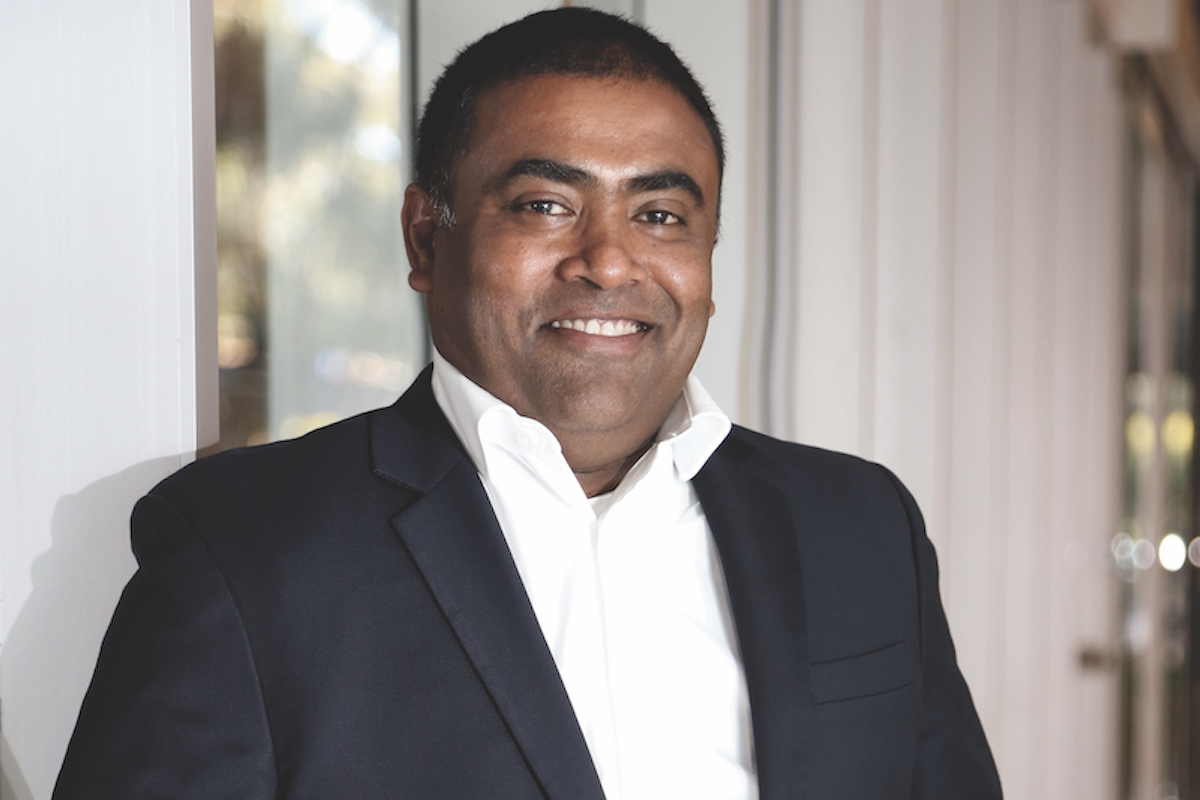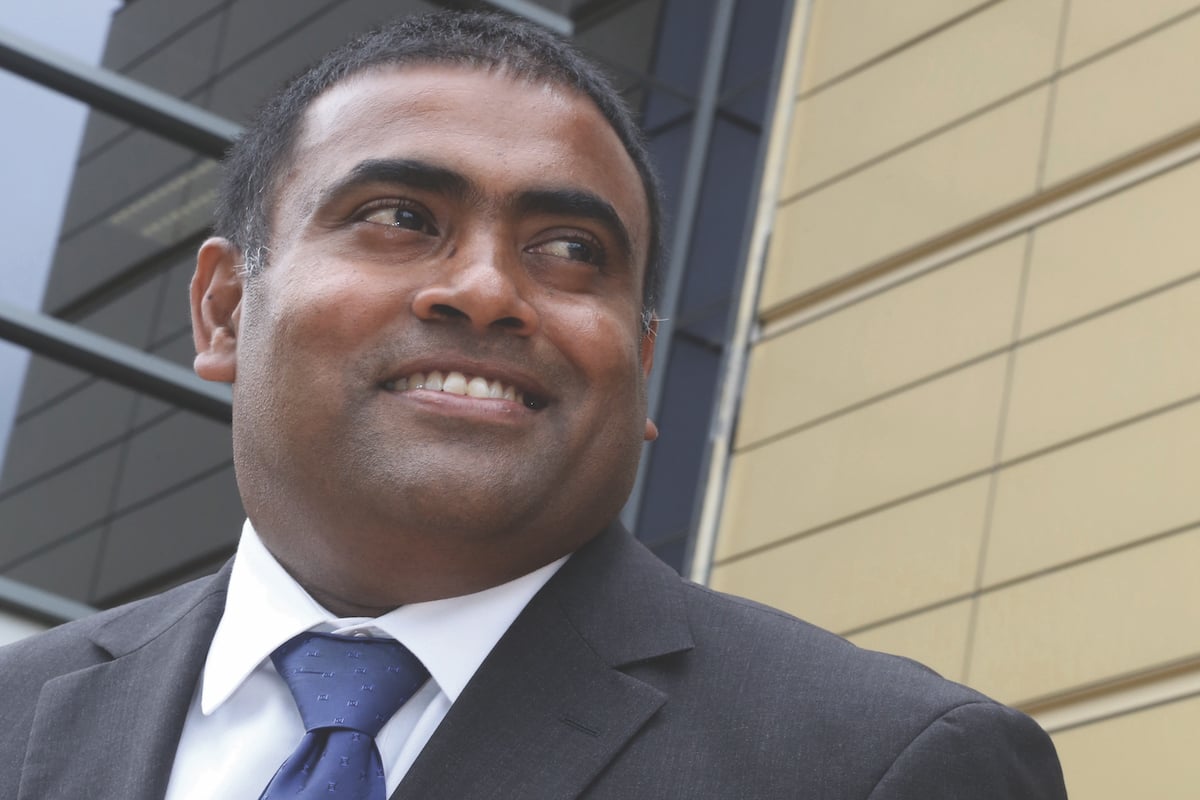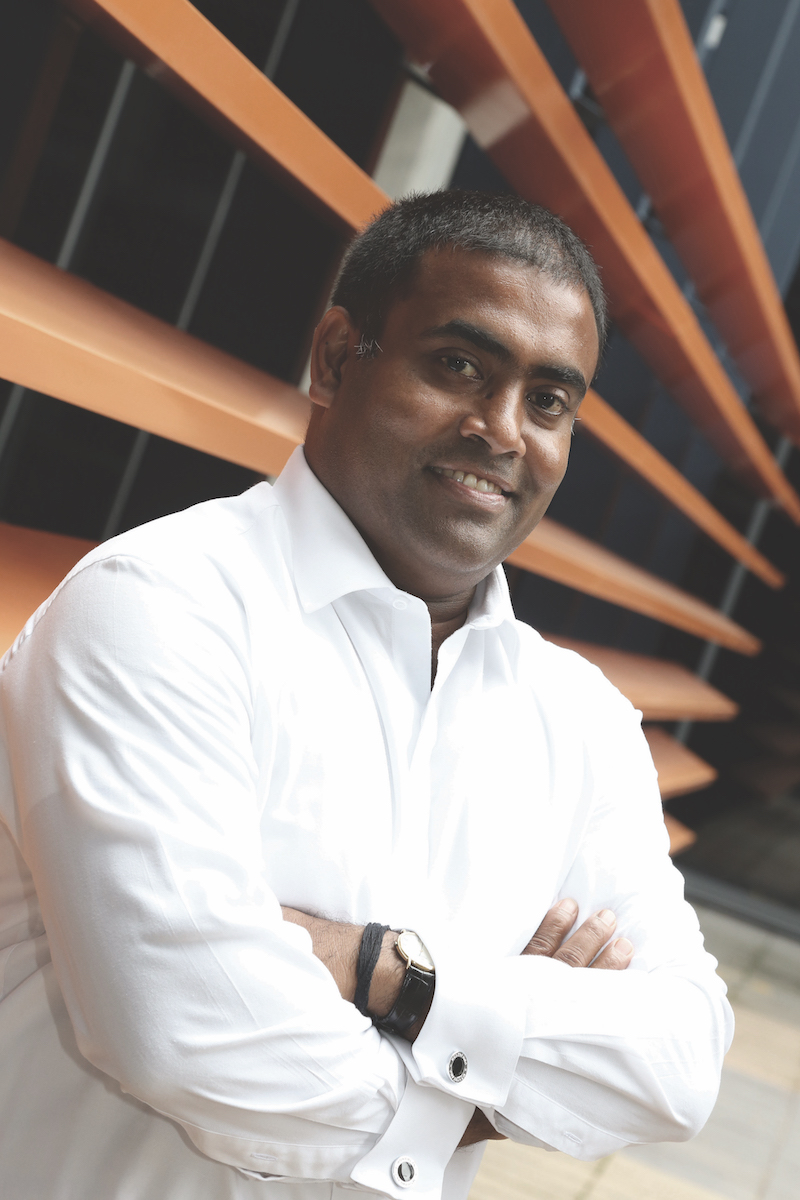For 26 years, Sri Lanka was embroiled in civil war. Until peace was declared in 2009, tens of thousands were killed, and hundreds of thousands more were displaced. Today, thankfully, the nation moves towards reconciliation, and has seen steady growth in recent years, as its economy moves towards urbanisation, manufacturing and services.
The unrest preceding the war, however, was a difficult time, especially for those growing up. For all the adversity he experienced, Seelan Nayagam, Managing Director of DXC Technology Australia, believes he also learned valuable lessons.

Seelan Nayagam, Managing Director of DXC Technology Australia
“In our family, there were always ups and downs,” Seelan recounts. “You were trying to survive. An experience like that teaches you a level of resilience, which was instilled by my parents.
You learn to always adapt, take setbacks in your stride and then to build yourself from there, trusting that times will keep you in good stead. Through my upbringing, my parents have taught me to deal with problems, pick myself up and then go forward.”
Seelan went on to study accounting and computer science at the University of Buckingham, though accounting failed to engage him entirely. He therefore decided to pursue computer science, which saw him spend a decade with IBM, moving into progressively more senior positions, overseeing the Asia–Pacific region.
“That led to the opportunity to join CSC (Computer Sciences Corporation), and it was a conscious decision,” says Seelan. “When I joined, I knew it would be a turnaround story, a transformation story. At that point, it was going to be a challenge. I felt that if we could execute our strategy, we would clearly change the landscape in the marketplace.”
With concepts such as digitisation and automation now firmly entrenched in industries across the world, Seelan took on the role because he believed he could play a part in building up both the capabilities of CSC itself and the digital infrastructure of Australia. His position as head of CSC’s ANZ division meant he could take an active part in both.
In March 2017, CSC merged with the Enterprise Services division of HP Enterprise to form DXC Technology. Today, the company boasts 130,000 employees across 70 countries, who assist in servicing nearly 6,000 clients, facilitating their transition to digital systems.
Though DXC has existed in its current form for only a few years, Seelan is impressed by the speed with which the company has found its feet.
“Last year was an incredible year for DXC, and unprecedented in change,” he says. “In the context of everything else, we’re the largest start-up in the world, both locally and globally, having formed from separate companies in 2017.
“ Last year was an incredible year for DXC, and unprecedented in change.”
As part of that merger, it would be remiss for me to say everything has gone according to plan. We clearly have some challenges, which we’re learning to work through in the spirit of continuous improvement. We’ll continue to do that moving forward.”
The challenges involved in a merger of two global corporations would have been a tumultuous period for all involved, not least Seelan himself. Of course, his childhood lessons of resilience would have been invaluable in helping him through that experience, and he’s certain that DXC has come out of the merger better able to serve its customers.
After all, DXC’s ambition is to be known primarily as a company that can help its clients thrive on change, and indeed succeed.
“Eighteen months ago, if somebody had told me that we can maintain our success through all this change, I would’ve been happy. But year on year, we’ve dramatically improved our Net Promoter Score.”
There’s no doubt DXC has been able to maintain that strong NPS and healthy customer relationships through its status as a world-leading, end-to-end IT services provider. Certainly in the ANZ region, it’s the largest independent provider, in terms of scale.
The company’s size has allowed it to engage in more in-depth support for its customers. For example, DXC has opened Digital Transformation Centres in Melbourne and Canberra, based on existing centres in Belgium and the UK.
By working with local universities, the Centres will encourage academia–industry collaboration, and, as well as improving communication with local clients, they’ll help upskill Australia’s IT workforce.
DXC’s partner network is comprised of 250 key partners worldwide 15 of those based in Australia, and is therefore considered a pillar of DXC’s growth strategy. “We treat our partner–supplier ecosystem as part of the DXC family,” Seelan says.
“We act as one when we go to our customers. Most of our partners have access to our offices. One of the most important goals for us was that we needed to work as one, a collective, in order to deliver the expected outcome to our customer base.”
DXC Australia hosted its annual Partner Advisory Council Awards in the Gold Coast last November, celebrating the accomplishments and contributions of its partners. In keeping with the company’s broad focus, the awards recognised not just the benefits these partners provided to DXC, but to the wider industry.
With the participation of more than 120 DXC partners, Seelan believes the event also serves as a forum to keep its suppliers informed, and solicit advice from partners, in a two-way communicative relationship that offers learning opportunities to all parties.
“ A successful leader is able to lead their teams to outcomes and results that they wouldn’t have thought possible to do alone.”
DXC works alongside its partners in the same way Seelan leads his team: by being forthright and open. “A successful leader is able to lead their team to outcomes and results that they wouldn’t have thought possible to do alone,” Seelan says.
“That’s what leadership is about. The way you do that is through clear communication, clear goal-setting, and most importantly, leading them to goals that they never thought were possible.
“I’m a big believer in sharing issues in the open, so you can do something about resolving them. Communication is not always easy. No matter how much you communicate, it may never be enough. You’ve got to have different platforms.
We have a collaboration platform that we use extensively to communicate with the teams, which also allows for teams to communicate among themselves with the same interest groups and so forth.”
Said collaboration platform is Workplace, an offering from Facebook. Implemented by DXC, the cloud-based collaboration program offers (what is for many people) a familiar user interface, ideally making it easy to use.
DXC was the first company to adopt the platform in the ANZ region, and not only has it found success here, it’s been implemented globally within DXC. Seelan says it facilitates communication across the company, a crucial task given the number of mergers and acquisitions DXC undergoes.
Throughout 2018, DXC integrated more than 10 companies, each one a distinct organisation with varying capabilities and growth. As a result, the company experienced a little difficulty in combining these companies, with some divisions declining while others grew faster than the market.
The solution was improved communication to better unify these previously disparate bodies, and to ensure internal cohesion.
“Integrating these companies brought its own set of challenges, which were around unifying the company’s culture, and defining it as we move forward,” Seelan explains.
“How do you implement significant changes without losing focus on our customers and, more importantly, the employees? From there, we need to work out how to lead the employees as we make those changes. To see this come to fruition is motivating and rewarding from a personal perspective.”

The efforts to engineer a smooth-running workplace has not gone unnoticed, with DXC named an employer of choice by global HR consultancy Randstad, based on a survey of thousands of Australian jobseekers.
Within the ANZ division, the IT services provider has also spent A$13 million on training and upskilling its staff. Naturally, Seelan gauges the organisation’s accomplishments through quantifiable success, being validated by and delivering solutions to customers.
But equally, the extent to which employees feel passionate about their work defines a large part of Seelan’s concept of success.
“Most importantly, throughout all this significant change, our employees are engaged, during both the good times and the difficult times along the way,” he says. “Our employee engagement continues to improve.
We see the employees focused on both delivering solutions to our customers and solving the problems we have, as we go through these integrations.”
To further boost the strength of its workforce, DXC has been running what it calls the DXC Dandelion Program, which was designed to help those on the autism spectrum find work.
“What we see is that those individuals have an incredible ability to recognise patterns,” says Seelan. “They’re typically successful in cybersecurity, testing and analytics, where their productivity and results are outstanding.”
This embrace of neurodiversity has been ongoing for four years, and its success has already been expanded to include those with dyslexia and ADHD. At present, it employs around 80 people across Australia, also providing leading research on autism in the workplace, with interest from hundreds of organisations around the world.
As it continues to expand the program, DXC has established partnerships with universities with the ultimate aim of building a pipeline of young talent for employers that are neurodiverse-friendly.
Seelan believes a workforce that welcomes neurodiversity creates a better internal culture that celebrates differences and uniqueness. “We have a retention rate of approximately 92%,” he says. “That’s unbelievable in a segment where a lot of companies are going down this path, but often struggle to retain their employees.
We’ve created an ecosystem that supports diverse thinking and allows these individuals access to meaningful employment, but also deliver outcomes for our customers.”
In October last year, DXC announced the expansion of the DXC Dandelion Program with the launch of a new DXC Social Impact Practice, aimed at helping clients and the community develop and run programs that benefit individuals and society.
But with many of these developments yet to be fully implemented, the Social Impact Practice remains most heavily focused on assisting those living with autism, and the transformational effect on their lives is something that gives Seelan purpose.
“It’s what we as an organisation have achieved to date in our social responsibilities,” he says. “It’s amazing to see people on the autism spectrum participate in meaningful work, delivering results to our customers. The customers recognise the value of these individuals. To see them having a normal life and getting married, buying a house, buying a car, is incredibly rewarding.”
The Social Impact Practice also includes plans to aid other disadvantaged groups within society, such as veterans, indigenous people, and those with disabilities. Alongside the government, a program based in Cape York has already established an indigenous workforce.
On top of this, an annual social challenge is chosen by DXC employees, to work towards solutions for issues they think can be addressed by technology. It’s not for nothing that DXC Technology was named the 19th Best Corporate Citizen of 2018 by Corporate Responsibility Magazine.
In the few years since it opened for business, DXC has enacted considerable organisational transformation, though it’s proven itself more than capable of handling this. Seelan is thus in an opportune position to assist the digital transformation of Australia, more so than at any point previously in his career.
DXC takes this broader societal role seriously, working alongside numerous groups adjacent to the digital industry. As well as supporting its clients, DXC collaborates closely with community, academic and governmental institutions to bring the country into the digital revolution.
“We participate in several ways,” explains Seelan. “One is leading our customers through their transformation to digitisation, since the industry is moving at an incredible pace, and we’ve been in the market for a long time.
Our relationship is substantial and longstanding with a lot of our customers, and helping them transform themselves along their digital journey clearly enables us to participate in the whole Australian economy.”
DXC’s digital capabilities are extensive, as is its ability to assist clients with digitisation, thanks to advances in areas such as cognitive AI and robotic process automation. Only a year ago, DXC released a “new digital-generation services delivery model” called DXC Bionix, which employs many of these innovations in a single IT services system.
The extent to which Bionix has improved IT service efficiency is remarkable: global delivery operations have gone from 50% to 80% time reduction, with substantial drops in defects, and costs and time of testing.
At the same time, DXC provides the industry with insightful research on surviving digital transformation, evidence of Seelan’s broad focus.
“The second key piece of our strategy,” he continues, “is contributing to the community and creating the skills necessary for our industry. We have a chronic skill shortage in this industry.
DXC is actively addressing this, by creating talent pools that previously haven’t been tapped. We’re working with universities to co-create courses that provide next-generational skills.”
As mentioned, DXC collaborates with universities as part of its Digital Transformation Centres. But this approach also extends to a partnership with TAFE in Tasmania, through which students have the option of working at DXC’s Tasmania facility.
At the end of their study, students are added to the company’s Young Professionals program, offering them a position with DXC.

The third major method of effecting change is by influencing policymakers. “For example, we’re a major contributor to a lot of the debates that take place in Canberra,” Seelan says, “all the way from cyber to the fibre network, and we actively contribute our point of view and perspective, which for us is an important part of Australia participating in this global digital economy.
One of the crucial areas here is cybersecurity, so we’re actively involved in guiding policies, providing leadership, and, importantly, imparting lessons that we’ve learned as a global organisation, to Australia.”
It’s appropriate that Seelan’s formative years provided those lessons of resilience – such is the fast-moving nature of humanity’s digital capabilities, that it’s no easy task to stay on top of it.
The IT industry is no different, and the tumultuous-though-profitable time since the CSC–HP Enterprise merger has proven to Seelan that there’s no benefit in playing things safe.
“Three years ago, I received a piece of advice about taking calculated risks,” he says. “It’s a significant part of learning.
“ You have to continue to challenge yourself and take calculated risks along the way.”
You have to continue to challenge yourself and take calculated risks along the way. You should never shy away from taking on those risks – correcting them if need be – and then moving forward from there.”






